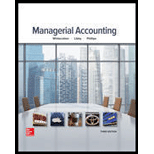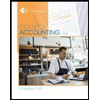
(a)
Introduction:
Inventory turnover ratio measures the number of times a company has sold its inventory.
Receivable turnover ratio measures the number of times company collects its
To calculate:
Inventory turnover ratio and receivable turnover ratio.
(b)
Introduction:
Inventory turnover ratio measures the number of times a company has sold its inventory.
Receivable turnover ratio measures the number of times company collects its accounts receivable.
To calculate:
Average days collection period of account receivables and average days to sell inventory.
(c)
Introduction:
Inventory turnover ratio measures the number of times a company has sold its inventory.
Receivable turnover ratio measures the number of times a company collects its accounts receivable.
To comment:
On the above results.
Want to see the full answer?
Check out a sample textbook solution
Chapter 13 Solutions
Managerial Accounting
- Can you solve this general accounting question with the appropriate accounting analysis techniques?arrow_forwardI need help with this general accounting question using standard accounting techniques.arrow_forwardCan you solve this financial accounting question with the appropriate financial analysis techniques?arrow_forward
 Managerial Accounting: The Cornerstone of Busines...AccountingISBN:9781337115773Author:Maryanne M. Mowen, Don R. Hansen, Dan L. HeitgerPublisher:Cengage Learning
Managerial Accounting: The Cornerstone of Busines...AccountingISBN:9781337115773Author:Maryanne M. Mowen, Don R. Hansen, Dan L. HeitgerPublisher:Cengage Learning College Accounting, Chapters 1-27AccountingISBN:9781337794756Author:HEINTZ, James A.Publisher:Cengage Learning,
College Accounting, Chapters 1-27AccountingISBN:9781337794756Author:HEINTZ, James A.Publisher:Cengage Learning, Financial Accounting: The Impact on Decision Make...AccountingISBN:9781305654174Author:Gary A. Porter, Curtis L. NortonPublisher:Cengage Learning
Financial Accounting: The Impact on Decision Make...AccountingISBN:9781305654174Author:Gary A. Porter, Curtis L. NortonPublisher:Cengage Learning College Accounting, Chapters 1-27 (New in Account...AccountingISBN:9781305666160Author:James A. Heintz, Robert W. ParryPublisher:Cengage Learning
College Accounting, Chapters 1-27 (New in Account...AccountingISBN:9781305666160Author:James A. Heintz, Robert W. ParryPublisher:Cengage Learning



